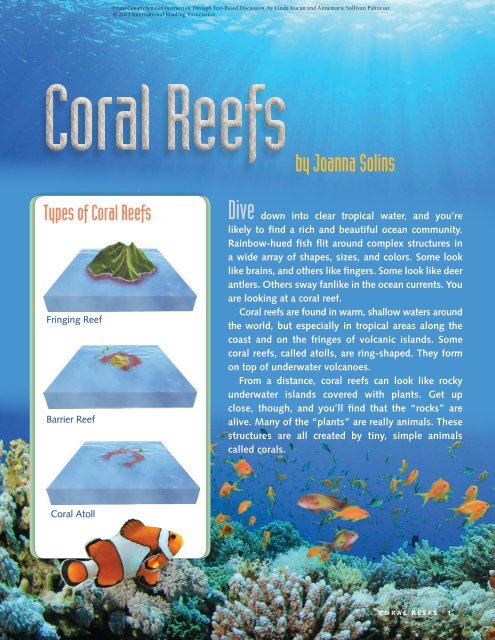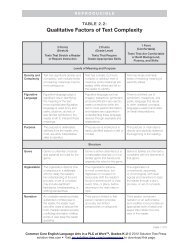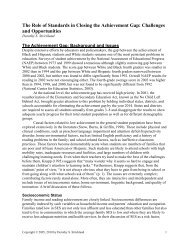Coral Reefs - International Reading Association
Coral Reefs - International Reading Association
Coral Reefs - International Reading Association
You also want an ePaper? Increase the reach of your titles
YUMPU automatically turns print PDFs into web optimized ePapers that Google loves.
y Joanna Solins<br />
Types of <strong>Coral</strong> <strong>Reefs</strong><br />
Types of <strong>Reefs</strong><br />
<br />
Barrier Reef<br />
Dive down into clear tropical water, and you’re<br />
likely to find a rich and beautiful ocean community.<br />
Rainbow-hued fish flit around complex structures in<br />
a wide array of shapes, sizes, and colors. Some look<br />
like brains, and others like fingers. Some look like deer<br />
antlers. Others sway fanlike in the ocean currents. You<br />
are looking at a coral reef.<br />
<strong>Coral</strong> reefs are found in warm, shallow waters around<br />
the world, but especially in tropical areas along the<br />
coast and on the fringes of volcanic islands. Some<br />
coral reefs, called atolls, are ring-shaped. They form<br />
on top of underwater volcanoes.<br />
From a distance, coral reefs can look like rocky<br />
underwater islands covered with plants. Get up<br />
close, though, and you’ll find that the “rocks” are<br />
alive. Many of the “plants” are really animals. These<br />
structures are all created by tiny, simple animals<br />
called corals.<br />
<strong>Coral</strong> Atoll<br />
C O R A L R E E F S | 1
Octocoral<br />
<strong>Coral</strong>s are related to jellyfish. Their bodies are water-filled sacs.<br />
They have a mouth surrounded by stinging tentacles. Unlike<br />
jellyfish, though, adult corals do not move around. Instead, they<br />
build cup-shaped skeletons to protect their soft bodies. Reefbuilding<br />
corals live in large groups called colonies. A single colony<br />
can contain thousands of individual animals, called polyps.<br />
Different species of coral grow in different patterns, forming the<br />
variety of shapes on the reef. The colonies grow larger as some<br />
polyps die off and leave their skeletons behind. New polyps then<br />
create skeletons on top of the old ones. Large reef-building colonies<br />
may grow less than one inch per year.<br />
<strong>Coral</strong> polyps use their stinging tentacles to catch tiny organisms<br />
that float by. They have another important source of food, too,<br />
though. <strong>Coral</strong> polyps have algae living in their bodies. The algae<br />
can use the sun’s light to create energy, just like plants. In return<br />
for nutrients and a safe place to live, the algae give the polyp<br />
oxygen and nutrients that it needs. Algae can provide a coral polyp<br />
with more than half of its energy. The algae also give the coral its<br />
beautiful colors. Most corals must live in shallow, clear water so<br />
that the algae can get enough sunlight.<br />
Elkhorn <strong>Coral</strong><br />
Pink <strong>Coral</strong><br />
C O R A L R E E F S | 2
<strong>Coral</strong> reefs are important for many reasons. They support a huge<br />
diversity of life. Though they cover less than one percent of the ocean<br />
floor, they are home to about 25 percent of ocean species. That’s more<br />
than a million different species! Humans rely on reefs, too. <strong>Reefs</strong> are<br />
home to fish that people eat. <strong>Reefs</strong> also protect beaches and coastal<br />
communities from pounding ocean waves during storms. They provide<br />
income for many people through the tourism they create.<br />
Unfortunately, coral reefs are in danger. Careless divers, people<br />
who collect coral, and poor fishing practices all damage reefs directly.<br />
Pollution from coastal developments and fuel from boats are large<br />
problems, too. They can poison the coral and make the water cloudy.<br />
In cloudy water, the algae living in the coral can’t get enough sunlight.<br />
C O R A L R E E F S | 3
<strong>Coral</strong> Bleaching<br />
Healthy coral with plant-like algae living<br />
inside polyps<br />
Bleached coral with algae being released<br />
from polyps<br />
One of the biggest problems facing coral reefs today<br />
is called “coral bleaching.” Under certain types of stress,<br />
corals can lose their algae. The term “bleaching” is<br />
used because corals appear white without algae. If<br />
conditions return to normal quickly, corals can replace<br />
algae and recover. Otherwise, they die.<br />
Scientists do not understand coral bleaching very<br />
well yet. They know that warmer water temperatures<br />
cause corals to bleach, but they don’t know why. One<br />
theory is that the warmer water stresses the coral. It<br />
produces fewer nutrients for the algae, so the algae<br />
leave. Another theory is that the warm water stresses<br />
the algae. The stressed algae produce less oxygen,<br />
and the coral releases them.<br />
Whatever causes the algae to leave, though, there<br />
have been many more coral bleaching events in recent<br />
years. Many people believe that global warming is to<br />
blame. When humans burn fuel, gases are released<br />
into the atmosphere. These gases trap heat. Many<br />
scientists now agree that all of the heat-trapping gases<br />
in our atmosphere are causing the global temperature<br />
to rise. Even a small rise in temperature can cause<br />
bleaching, so global warming is a threat to corals.<br />
People around the world are working to help coral<br />
reefs. You can, too. If you are lucky enough to visit<br />
a reef, make sure that you learn how to enjoy it<br />
without causing damage. Never take home a coral<br />
souvenir.<br />
Even from home, you can make a difference. By<br />
conserving energy and reducing trash and pollution,<br />
you can improve the environment for coral reefs.<br />
Dead coral skeleton covered with thread-like<br />
algae or plants growing on the outside<br />
C O R A L R E E F S | 4

















